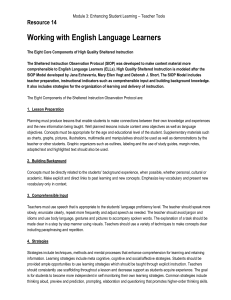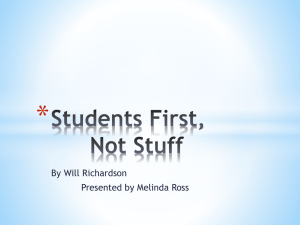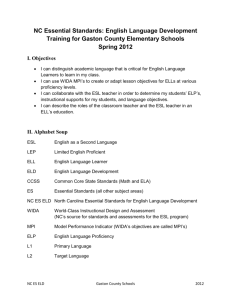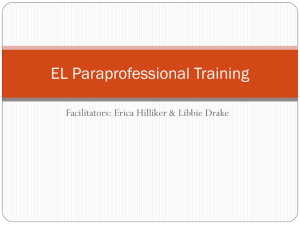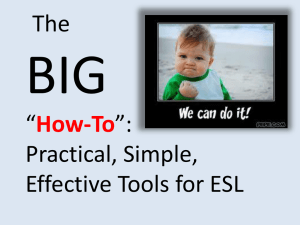differentiating instruction for English learners
advertisement
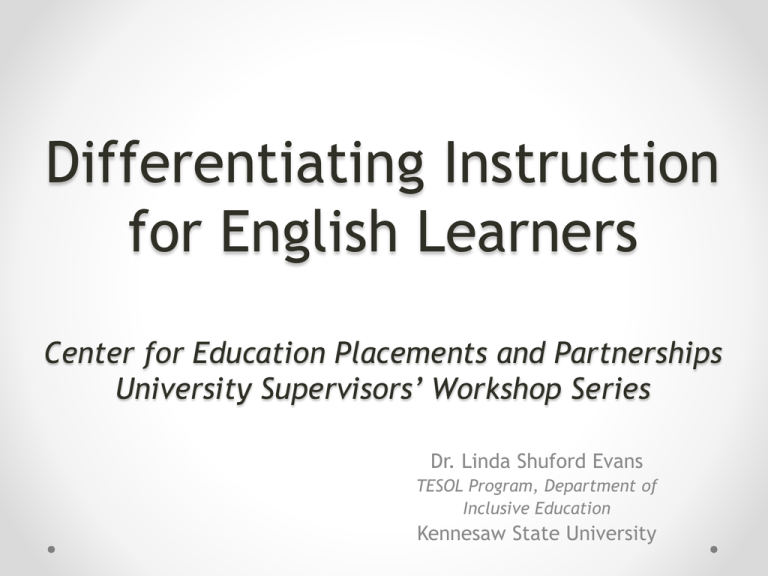
Differentiating Instruction for English Learners Center for Education Placements and Partnerships University Supervisors’ Workshop Series Dr. Linda Shuford Evans TESOL Program, Department of Inclusive Education Kennesaw State University Aims for the Workshop • What do we mean by differentiating instruction for English learners? o Learner characteristics o Language considerations o Cultural considerations • What guidelines are available to facilitate differentiation for English learners? o WIDA o Sheltered Instruction • What would I look for as a field placement supervisor if I wanted to determine whether differentiation for English learners was happening in the lesson? English Learners in the US • Demographics o Changing populations o Primary languages Mapping language English Learners in Georgia Students of Hispanic/Latino Heritage in Georgia Conclusions? We’ve got a lot of work to do as educators! Teacher education is a critical element in improving the educational attainment of English learners. Question 1 What do we mean by differentiating instruction for English learners? Partial answer: The same thing we mean when we differentiate for any student… learning styles abilities interests But with a particular emphasis on language in our instruction. Language as a Learning Vehicle • How important is language to a student’s understanding of a lesson? http://tapestry.usf.edu/Nutta/ Who are our learners? Jaime—Grade 2 Born in NYC; father works as custodian & mother stays at home with baby sister. Emilia—Grade K Born in Mexico; parents are migrant workers. Phuong—Grade 10 Born in Vietnam; family owns a restaurant. Ernesto—Grade 8 Born in Georgia; mother is a doctor & father is an engineer. Francois—Grade 5 Born in Haiti; mother is a nurse. Pause & Reflect If you were going to plan instruction for your student, what would you want to know about him/her? (groups/cards/share) Students may vary with regard to… • Prior schooling experiences • Oral language abilities in native/home language (vocabulary—how many words?) • Oral language abilities in English • Literacy levels—reading and writing—in native/home language • Literacy levels—reading and writing—in English • Similarities between native language & English (grammar, orthography, pronunciation) Students will also vary by… • Prior life experiences (migrant, immigrant, refugee, U.S. born) • Familiarity with the topic of the lesson • Interest in the topic of the lesson • How long they have been in the class (continuity from previous lessons) • Learning styles/preferences • Personalities Let’s look a little more deeply at academic language — the language of school and school tasks. Let’s start with vocabulary… The Astoundingly Critical Nature of Vocabulary only 8-10 words can be taught directly each week = approx 400 words native English speaking children acquire approx 1000 words per year enter K with approx 5000 words lower SES cuts that approx in half the rest are learned incidentally Pause & Reflect : What are some sources of incidental word learning in a lesson? Background Knowledge Concepts and Language -- Relationship IDEAS ASSOCIATIONS CONCEPTUAL DEVELOPMENT SCHEMA EXPERIENCES VOCABULARY Question 2 What guidelines are available to facilitate differentiation for English learners? Two answers: WIDA Standards Sheltered Instruction WIDA: World-Class Instructional Design and Assessment Guidelines for four language domains: o Listening o Speaking o Reading o Writing At five proficiency levels for each: o Entering o Beginning o Developing o Expanding o Bridging In five areas: Social & instructional language plus the language of Language Arts, Math, Science and Social Studies. WIDA: World-Class Instructional Design and Assessment 2012 Amplification of The English Language Development Standards, K12 (link) Language Evaluation: ACCESS • Students are administered the ACCESS test each spring. • Students receive scores in the following areas: o o o o o o o Listening Speaking Reading Writing Oral language Literacy Comprehension • Scores range from 1.0 to 6.0 in each of the areas above. • Teachers have access to the scores, so the student teacher will as well. The scores should be used to guide instruction and differentiation for the range of language abilities in a group or class. • NOTE: The use of composite scores is not recommended. • WIDA guides for language levels and considerations across content areas… • Sheltered instruction operationalizes the WIDA standards. SIOP: Sheltered Instruction Operational Protocol Sheltered Instruction http://www.youtube.com/watch?v=Ty3n07UaFUU SIOP Lesson Delivery http://www.youtube.com/watch?v=lVGbz4EqyGs What to look for? Aligned to state & national standards Aligned to WIDA Standards Are the language and concepts in the lesson comprehensible to all of the students? See sample lesson template Applying Differentiation Strategies for English Learners 1. Appropriate planning for both content and language objectives that account for students’ strengths and needs. 2. Effective delivery of instruction with multiple modes of participation in the language domains. 3. Appropriate and differentiated assessments that effectively evaluate students’ learning/achievement of objectives. Making Lessons Comprehensible “…differentiated instruction is not the same as individualized instruction. Every student is not learning something different; they are learning the same thing, but in different ways…differentiating instruction is a matter of presenting the same task in different ways and at different levels, so that all students can approach it in their own ways” (Trujo, 2004). Ideas for Differentiating for English Learners Classroom environment o Arrangement of furniture/room to allow for collaboration and different types of activities based on needs of students o Grouping – flexible groups that change depending on the objectives and domains being emphasized. o Resources – word walls, picture dictionaries, listening centers, reading centers with leveled books, personal dictionaries & word lists Comprehensible input – provide alternate ways of accessing key content Charts Books in native language Simplified text Realia Movies/video support Slower speech Gestures Hands on activities Activating/building background knowledge o Pre-teaching key vocabulary o Providing follow-up practice opportunities o o o o o o o o o Pause & Reflect Thinking about your particular English learner and their language domain levels, how could a student teacher modify a lesson to differentiate for the student’s particular strengths and needs? (chart paper/share) Additional Videos Grade 1 Example http://www.youtube.com/watch?v=9gh196iaQfA Shaping the Way We Teach English: Individual Learner Differences http://www.youtube.com/watch?v=ETHQztHHqKM Article: http://www.colorincolorado.org/article/41025/?theme=p rint Many thanks! Linda Shuford Evans levans39@kennesaw.edu
